SCULPTURES
Lalitankura Pallava Griham, A neglected Pallava treasure on Tiruchirappalli Rockfort
by Prof. Subramanian Swaminathan
e-mail: sswami99@gmail.com
e-mail: sswami99@gmail.com
6 April 2025
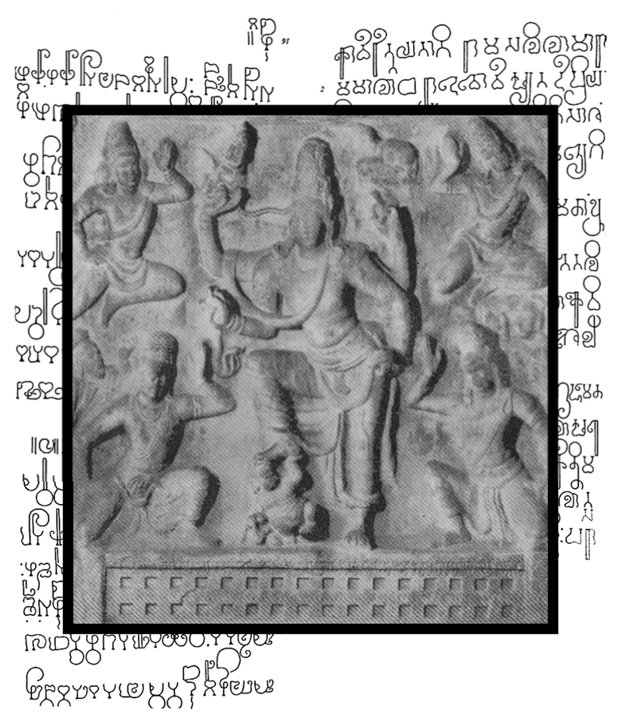 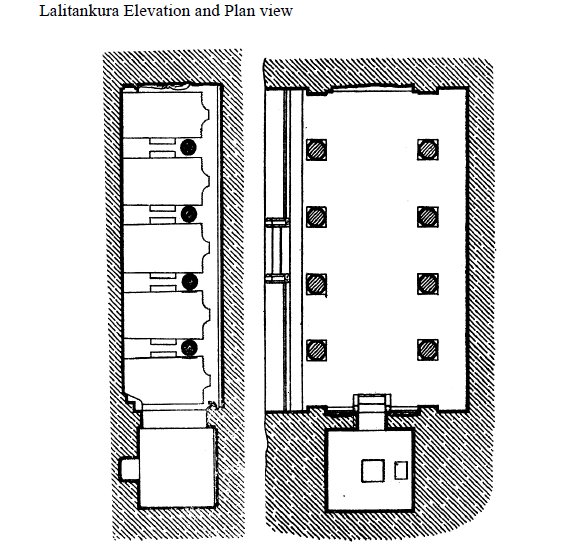
There are two iconographic compositions which owe considerably to the
Pallava-s: the Somaskanda and the Gangadhara. Perhaps the former is a
special Pallava conception. Both these have captivated artists through
the ages.
The earliest, (or is it one among the earliest?), is Mahendra Pallava’s
Gangadhara in the cave temple in the Rockfort complex at
Tiruchirappalli. The popular shrines of Tayumanavar and of the Uchchi-
p-pillaiyar are much fancied by the devout and only an occasional art-
buff enters the precincts of the cave temple that houses this Siva
composition. Then there are pilgrims who rest their tired limbs on their
way back from the strenuous climb atop, and the noisy hangers on who
crowd every place of religious or cultural fame. The cave temple
deserves better.
It is not the cave temple alone that deserves better. There are at least
two more ancient sites that should have been in the itinerary of the
public. One is an ancient site, older to the Pallava cave by about 500
years. It is a cavern, a holy resort of Jain ascetics. To attest this,
we have stone- beds where the holy men practised severe austerities and a
number of inscriptions, the earliest being in Late Tamil Brahmi of the
3rd century AD. Unfortunately this is lost, again due to our negligence.
Three inscriptions in Early Vattezhuttu have been found and these are
dated to the 5th century AD. All these mention the name of the patrons
of the Jaina ascetics.
At a lower level is another cave temple. This was excavated by the
Pandya-s perhaps a century later to the Pallava one above. A family
lives in the precincts, unhelpful enough to drive away straying
visitors. I suggest that the Trichy-wallahs pay a visit to this temple
also, as this is believed to have been designed following the Hindu
Shanmatha doctrine of Adi Sankara. (I wish some God-person attributes
some divine powers to the gods hiding in these caves. Perhaps this is
the only way today to make people ‘honour’ these divinities!)
Importance of the Temple
First let me state in brief why the Pallava cave temple is important.
Firstly, it is one among the earliest cave temples of the Tamil country.
It is believed that the Pallava-s introduced excavating hard rock in
the south. May be the Pandya-s were doing this around the same time. At
least Mahendra Pallavan boasts so in his Mandagappattu cave shrine. The
Tiruchy cave is the southern most cave of the Pallava-s. How come he
came all the way to Tiruchy to excavate a cave temple in an inaccessible
hill, we don’t know. Was it under his rule at that time, I am not sure.
But here we have one which is important in the art and religious
history of India. We must try to imagine how this hill would have looked
with out the Tayumanavar Koil, Uchichi-p-pillaiyar Koil and all the
sundry shrines, and then we may wonder how Mahendra chose the site at a
height of 200 feet and how his artisans managed the excavation. Like the
other Pallava monuments this cave temple also holds some puzzles.
The Temple
The cave temple, a typical early Pallava style, is dedicated to Siva.
Mahendra calls the shrine Lalitankura-pallavesvara-griham. Lalitankura
is one among the many titles of Mahendra, and it means ‘charming-
scion’. This name is found on the girder connecting the two inner
pillars of the cave temple. The sculptural content includes two Pallava
dvara- pala-s guarding the now-empty garbha-griham and the famous
Gangadhara panel in bold relief. This panel is an exquisite composition.
It is a pity that all of us miss it. I shall be discussing about it in greater detail alter.
Inscriptions
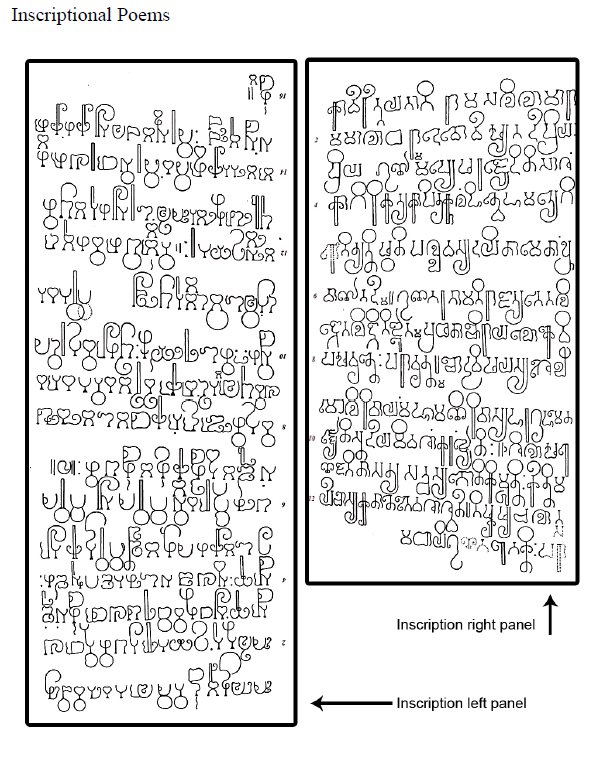 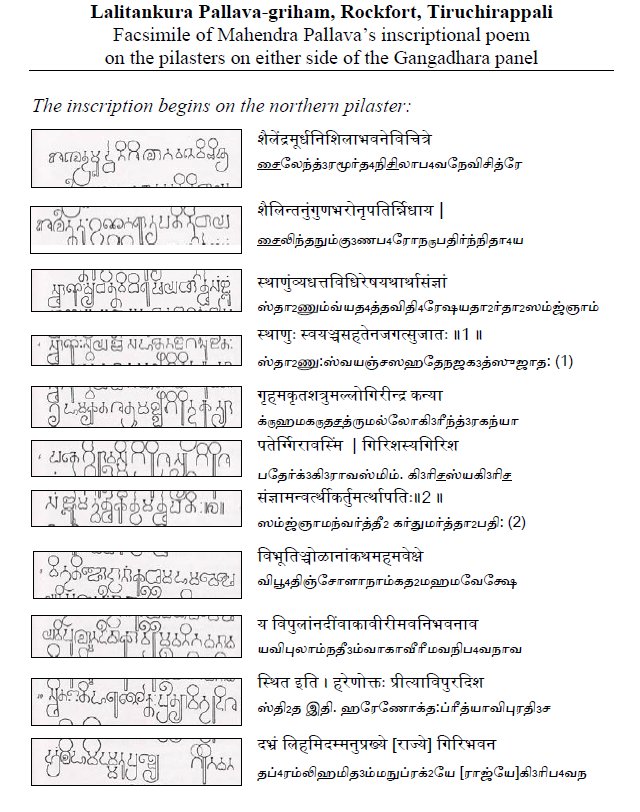
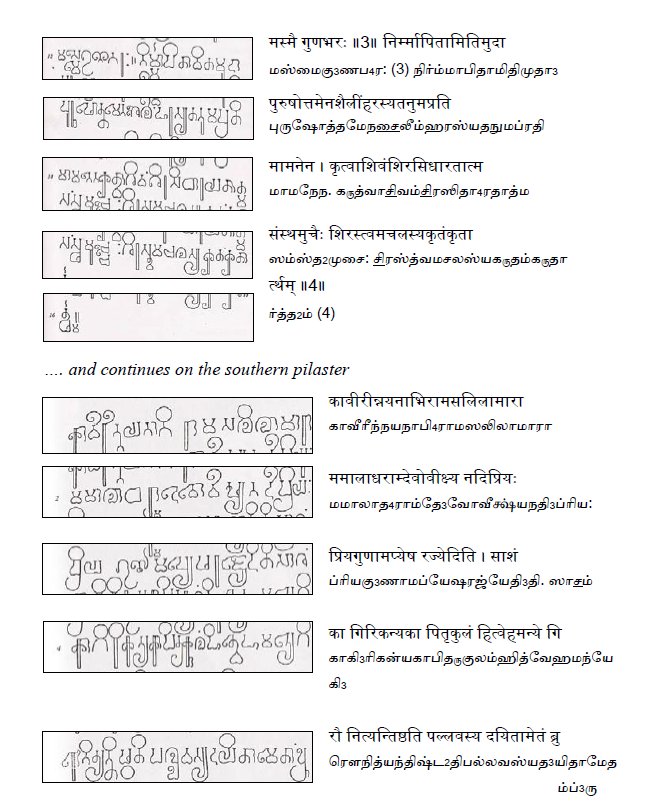 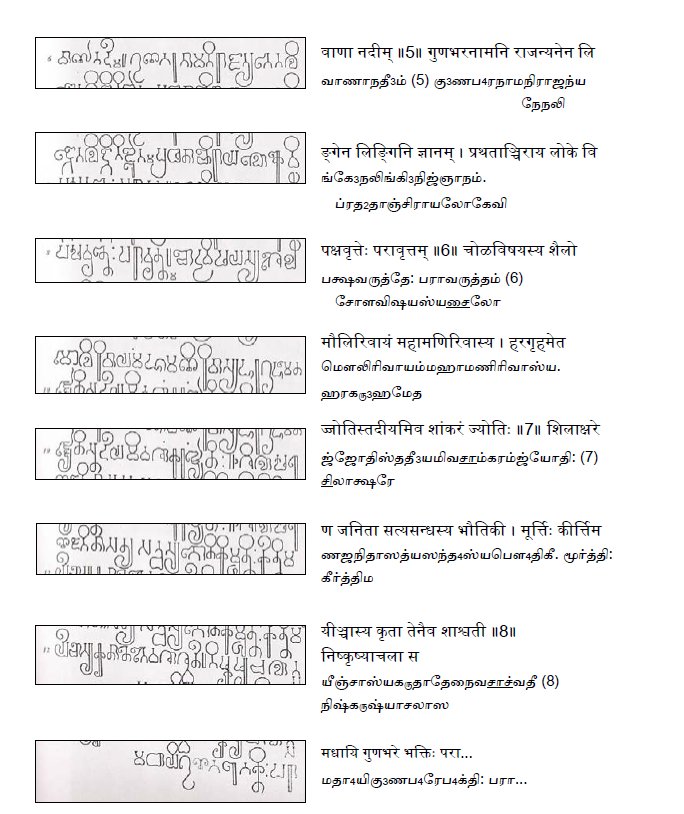
Transliteration and translation of Mahendra Pallava’s inscriptional poem on the pilasters on either side of Gangadhara panel
That the cave contains some important inscriptions is another special
feature. Some of them are the routine listing of the innumerable titles
(biruda-s) of Mahendra Pallava, a decease that infects our rulers of the
past and the present. There are 80 of them engraved in this shrine,
mostly on the pillars. (Mahendra can boast of almost 130 titles! His
great-grand son, Rajasimha, had even more, about 250!) But a poem
consisting of eight couplets, most likely composed by the king himself,
not only describes the Gangadhra panel that it encloses, but also
presents a puzzle, an example of dhvani normally met with in Sanskrit
poetry, here for the first time in a sculpture, to be handled again by
his son in the Great Penance panel in Mahabalipuram.
Pallava Grantha script
I may take this opportunity to mention some thing about the script in
which the inscriptions are written. The language of the couplets is
Sanskrit, and they are written in the script called Grantha, or more
appropriately, Pallava Grantha, giving credit to the inventors. It is a
script used in the Tamil country to write Sanskrit. It was so till the
last generation. It is also the one from which developed the script for
Malayalam, and, hold your breadth, script for most all the languages of
the East: Java, Sumatra, Borneo, Thai, Laos, Khmer, Combodia, Vietnam
etc. This happened through the political and cultural conquest of the
East by the Indian rulers, starting with the Pallava-s.
General description of the Temple
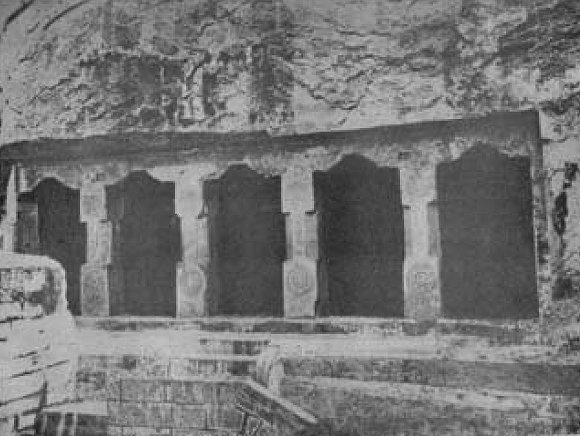
To start with I will give a general description of the cave temple. When
you cross the gate that takes you to the Uchchi-p-pillaiyar temple, you
find on the left the cave temple, called by a mouthful name,
Lalitangura Pallavesvar Griham. What you see is a cave supported by
four pillars with two half pillars
(technically called pilasters) on each end. The façade looks rather
simple. The pillars are plain, square in cross section at the bottom and
top, but eight-sided in the middle. This is typical of early Pallava-s.
The pillars become more and more sophisticated, and to some extant the
design of the pillars gives clue to the chronology of the caves
themselves. There are circular low-reliefs on all the four sides of the
pillars. They are beautiful geometrical shapes, worth a close look. The
brackets above the pillars are again plain. Titles of King Mahendra are
inscribed on the faces of these pillars, mostly in Pallava Grantha and a
few in the Tamil script.
Beyond the pillars is a mandapa (hall), and in the rear the hall is a
series of four pillars very similar to the ones in the front. The
medallions on the faces of these pillars are again worth a few minutes.
To your right, that is, on the eastern wall of the cave, is the
garbha-griham (sanctum).
Garbha-griham

Many of the features of the garbha-griham proclaim its Pallava origin.
First let us look at the dvaral-pala-s (gate-keepers) that guard the
shrine. One on each side, they are carved in bold-relief. They are
similar in certain respects. Both are in semi-profile, two-armed turned
towards the shrine-entrance, standing with one leg bent and raised up
and the other planted firmly on the ground, carry a massive club, their
palms resting on it, etc. When you find time you may look at the
sacred-thread they are wearing, their dress and ornaments. These would
reflect the contemporary fashion.
The garbha-griham is almost a cube of about 9-foot each side. There are
two pits, one, we can guess, is for the lingam to be installed. But what
about the other? Was lingam the object of worship in the Pallava cave
temples is the question that is being debated by pundits. I shall also
be touching upon this later.
Gangadhara Relief Sculpture
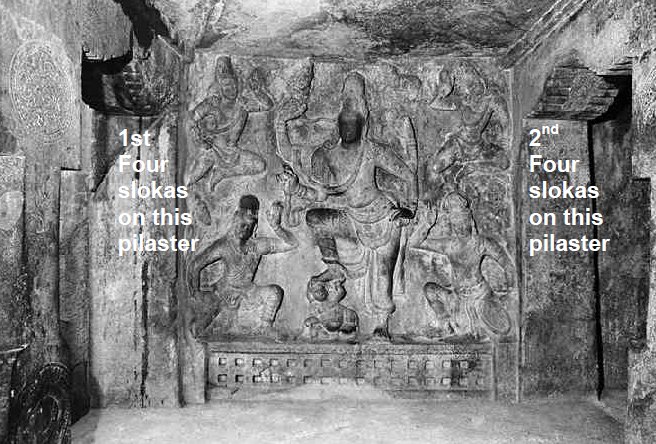
Now let us look at the western wall, the main object of our study.
Here is the celebrated Gangadhara panel. This is a large
composition. In the center is Siva as Gangadhara with attendant figures
on the sides and top.
Let us start with the hero. The four-armed Siva is standing with His
left leg planted firmly planted on the ground. His right foot is raised
and is held up by the head and an arm of a crouching Siva-gaNa below.
Siva’s upper right arm holds a strand of His tresses into which Ganga is
descending. Ganga is shown in the human form, a small female figure
with both the hands in the ‘namaste’ posture.
The lower right hand of Siva holds the tail of a serpent with its hood
raised up. His upper left holds an akshara-maala and the lower one rests
on His hip. These are conventional postures. Now let us look at the
make up. His sacred-thread is vastra-yajnopaveeta, namely, made of
cloth. The ornaments can be listed: coiled valaya-s around the wrists,
elaborate keyoora-s above His elbows, makara-kunDala-s on both ears,
large enough to rest on His shoulders, a broad necklace, an udara-
bandha round His belly.
Siva’s head-dress is an elaborate jaTaa-makuTa, a rather unusual one. It
is decorated on the front and held in position by a coronet. Rest of
the jaTaa is coiled on the top. On the top right side is the
characteristic moon and at the bottom, but on the left side is a skull.
Behind the head is the siraschakra.
Let us look at the dress. His veshTi, reaching up to both the ankles
with the central fan-like pleat of the kachcha hanging between legs, is
worn the way it is done even today, a example of continuity in
tradition. But the artists have done this excellently, every fold, clear
and crisp. Round His waist He wears a kaTi-bandha. Another uttareeya
hangs loose in a loop in front and has tassels on either side. Isn’t
this a remarkable composition?
Now let us follow the other actors in this scene. I have mentioned the
gaNa whose head and palm are supporting the right leg of the Lord. The
crouching gaNa, identified with Kumbhodara, holds a serpent on his right
hand. On the other side, corresponding to the descending Ganga is found
an animal, not easily distinguishable. Because of the prominent hump it
could be a bull. Is it taking the place of vRshabha-dhvaja?
On either side on the top are two flying vidya-dhara-s. Below, kneeling
on either side of Siva, are two identical figures. All these four
figures are attired very similar to the Lord, with the lower pair being
somewhat less ornamented. Their one arm raised in adoration and the
other on the hip. Who could these people, in the royal dress in Siva’s
camp? They look out of place in the Shambo-ki-baraat! We shall come back
to this later. Behind the two kneeling figures are two identical
rishis, identified by their huge jaTa-s and bearded face. Their inner
hands too are raised in veneration.
Now let us take a few steps backwards so that we can get a full picture
of the panel in order to appreciate the beauty of the composition. This
bas-relief is an outstanding composition. It is also the earliest
composition in the Tamil country. That the artist could achieve
aesthetic excellence on their very first attempt is astounding. This
must have inspired his illustrious son, Narasimha Varma, to attempt the
world’s first open-air bas-relief in Mahabalipuram. I may mention that
Mamalla’s unique contributions to the world of art are two: the
monoliths and open-air reliefs. The former had inspired quite a few,
including the incomparable Kailasanatha Temple in Ellora, but none
attempted the open-air reliefs there after!
The whole composition is an illustration of total balance. It exudes the
Pallava grace, every square inch of it. Every character is perfectly
modelled. There is no overcrowding, no dramatisation. It is beauty in
simplicity. Worthy of contemplation, so savour the scene as best as you
can. I don’t want to say any thing more, it would speak for itself.
(Proverb)

On either side of the panel are two half-pillars (pilasters, if you are
too technical) on which is written 8 couplets, four on each side, in
Sanskrit in the Pallava Grantha script. I have mentioned before this
inscription is important. It is important for variety of reasons. First
it is a great poetry composed by the king himself. We may keep in mind
that Mahendra Pallava was an all-rounder. His political achievements are
legendary. He also initiated excavating cave temples in hard rock in
the south. He wrote two satirical plays, Mattavilasam and
Bhagavatajjukam. He was also a great painter/artist:
chitra-k-kaara-p-puli is one of his titles (self- given!).
The inscription caught the attention of the early epigraphists and the
meaning of the epigraph is debated even now. The first to translate was E
Hultzsch in 1890 and his reading is more or less followed even today by
most epigraphists. May his tribe increase! We should salute these
pioneers. But I am going to follow the interpretation of Miachael
Lockwood and his multi-disciplinary team from madras Christian College.
This is because their interpretation appeals to me. (You may wish to
follow Hultzsch if you desire. After all we live in a democracy.)
I propose to give a gist of the inscription first and then point out the
differences with the interpretation of Hultzsch. To help you to follow
the inscription at the site I am including the inscription, its
transliteration and translation.
Transliteration and translation of Mahendra Pallava’s inscriptional poem
The first sloka states that King Mahendra established a stone figure of
Siva in the cave temple of on the top of this hill in his own image, and
became ‘immortal’, like the God, on the earth.
The second stanza explains why Mahendra chose a hill. He says that he
chose the hill to justify Siva’s name as Girisa (mountain-dweller).
The third verse purports to explain the circumstances and the manner of
choice of this hill. Mahendra says that when proposed an earthly abode,
the God wondered how he can remain on the earth without seeing the
fertile country of the Chozhas and the river Kaveri. Then the king chose
the spot atop this Tiruchy hill facing the river.
The fourth describes how the temple became a reality. Here there is an
identification of God and the king.
The literary composition continues on the right pilaster. In this fifth
one the king is mischievous. Ganga, the daughter of Himavan, now fearing
that the Lord may become infatuated with the river Kaveri, let Her
mountain-dwelling to reside here along with the Lord. Here Lockwood et
al differ from the popular conception. Hultzsch read this stanza as
Parvati feeling worried came to reside with Her husband. I will talk
about this a little later.
The sixth verse says that he (Mahendra) himself has become embodied in
the image of Gangadhara. The whole poetry is supposed to be full of
double-meaning, more than one meaning. Sanskrit literature is famous for
this, called Dhvani.
The next verse says that the mountain was the crest-jewel of Mahendra’s Chozha province, this abode of Siva its chief jewel.
This last one is important. It says that through this stone-Siva, a
physical embodiment of Satyasandha (a title of Mahendra) was created,
and through this form, his fame was made eternal. By the way the
traditional understanding, that is, of Hultzsch and his followers,
differs from this.
Dhvani in Sculpture
I mentioned before that the poem and the sculpture are examples of
dhvani, an essential ingredient of Sanskrit poetry. Also mentioned was
that Mahendra was a great literary figure. His being a sakala-kala-
vallavan resulted in the dhvani being used in sculpture. And it is the
first time in history. His son contributes another first in his magnum
opus, in the Great Penance composition in Mahabalipuram, that is dvi-
samdhaana-kaavya (double-entendre poem, that is, a two-in-one poem). At
least some think so.
What is dhavani? Poetry may possess two levels of meaning: direct
meaning and a suggested meaning. This suggested meaning that appeals to
an aesthete is really the soul of poetry. This feature is called dhvani.
Thus the 8-stanza poem has both direct and suggested meanings. So the
sculpture too.
The poem directly refers to Siva as Gangadhara. The suggested meaning
could be Mahendra. Now let us look at closely. You may recall that
Mahendra specifically says that the Lord is made in his image. (What a
vain-glory!) So in the suggested meaning we may start with the hero
being the Pallava king himself. But what about the other characters in
the scene. Normally one finds a few divine characters, like Brahma,
Vishnu, Narada etc. In addition there would also be a few rishis and a
few bhoota-gaNa-s in attendance. In fact, the darbar of Siva has earned
the sobriquet Shambu-ki-barat (‘Shambu’s-friends-and-relatives-in-His-
wedding-entourage’) because of its motley composition! We have a gaNa,
four princely characters who can be taken for some divinities though
unidentified and two rishis in the background. We have an animal – we
couldn’t decide whether it is a bull or a dog – above Siva’s upper left
hand. A rishabha can be taken as appropriate, but if it is a dog, what
is a doing in this place? By the way dog is found in the Gangadhara
panel in another Pallava creation, the Kailasanatha Temple in
Kanchipuram, and again in the Kailasanatha Temple in Ellora, a
Rashtrakuta miracle. Various theories float around, and it looks these
are not convincing even to the floaters.
We shall then listen to Lockwood on the suggested meaning. The panel is a
celebration of Mahendra also. In the centre stands the Emperor
majestically. The four princely figures are the feudatories of the
Pallava-s. Two of the dynasties are represented here. The western Ganga,
identified by the namaste-ing Ganga seen on the left and the Kadamba-s
identified by the dog on the right. But how do you connect the Kadamba-s
with dog? It happened this way. Lockwood, while going through old
journals on Indian history, found that the Kadamba-s used dog-emblem in
their copper-plate grants”! While there is no doubt that Mahendra
Pallava was very creative, we now must accept that Lockwood is also very
imaginative!
Let me now point out the contributing factors to this double meaning.
The most important are the extraordinary and numerous titles of
Mahendra. I mentioned that he assumed more than 130 titles for himself.
Many of them are also the names of Lord Siva. The king skillfully weaves
these names into his poem to effect this double entendre. GuNabhara (I
and VI slokas), Purushottama (IV sloka) and Satya-sandhaa (VIII sloka).
Further he has skillfully employed words which could be understood in
more than one way. For example, the mountain itself may mean the
Himalayas or our own Tiruchy rock, it may be Parvati or Ganga by
daughter of mountain (gireendra-kanya) etc. To add to the poetic
alankaram words have been used adroitly. For example, sthanu is used in
two meanings, one to refer to the God himself and the other to mean
fixed, immortal, that this, the king has this become ‘immortal’.
The Pallava-s, as a dynasty, seemed to enjoy teasing. Many of the
Pallava monuments are puzzles. Some look to be intentionally made by the
Pallava-s themselves. There are so many, particularly connected with
the monuments in Mahabalipuram. Here the puzzle is: ‘Where is situated
the God mentioned in the poem?’
Lockwood’s new interpretation
Now let us look at two different solutions to the puzzle. As for as this
Gangadhara panel Hultzsch translated the word ‘nidhaaya’ as ‘placed’.
He also took gireendra-kanya to mean Parvati. So he, and the subsequent
people, looked for an anthropomorphic (sorry for art-ese, it simply
means ‘human-like’) idol of Siva and Parvati, naturally, in the
garbha-griham. To add to the confusion, there are two pits in the
garbha-griham. OK, one for Siva and the other, His consort. That fits
in. But what does not fit in is that Parvati image was not generally
installed in the sanctum. (Also, it is generally not a lingam that is
installed in the early Pallava sanctums. It could be a Somaskanda in
panel on its rear wall.) Hultzsch and the others did not consider that
the poem could refer to the Gangadhara panel, around which the poem is
engraved. This is in spite of the fact that the poem explicitly states
that the builder has made the God in his image. Another error of
judgment on the part of Hultazsch was, according to Lockwood,
understanding the expression ‘daughter of mountain’ as Parvati. Lastly,
Hultzsch misread (again according to Lockwood) another word. The word
was silaakshara in the 8th stanza. Hultzsch thought it is scribal error
and corrected it editorially as silaakhara, and translated as
‘stone-chisel’. But the word is bold and clear. Why did he do that? He
simply felt that this fits in with his interpretation.
Now our recent Poirot (all of you know this chap, the detective in the
Agatha Christi novels) cleared all these. Firstly, Lockwood translates
the word nidhaaya to mean ‘established’. Then he is of the view that by
‘daughter of the mountain’ the author refers to Ganga, and not Parvati.
Then was Ganga a daughter of Himavan? For this he points out that in
Ramayana, where the story of Bhagiratha is narrated Ganga is mentioned
as the eldest daughter of the King of Himalayas. Lastly, Lockwood
considers that there was no scribal error in silaakshareNa, and this
means ‘imperishable stone’, and then this meaning also fits in. And
there can be a few more interpretation. You may attempt. But, then you
will have to visit the shrine. Then my purpose is fulfilled.
You may ask me why I go into such a depth. If the matter is so important
to result in a number of research papers in reputed journals, and if
this is about one of our own monuments, shouldn’t we be aware of it? May
be we can also look at it our own way and come up with more innovative
theories.
|